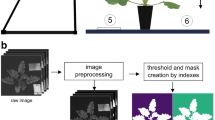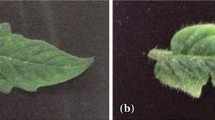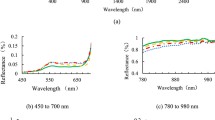Abstract
Fusarium oxysporum f.sp. radicis lycopersici (FORL) and Fusarium solani (F.S.) are common fungi responsible for crown root rot and vascular wilt diseases that highly impact the development of plants, causing significant yield losses. This study investigated changes in the hyperspectral reflectance of normal and Fusarium (FORL and F.S.)-infected tomato plants in a growth chamber at different disease stages (3, 10, 16, 23, 31 and 37 days after inoculation (DAI)) using a spectroradiometer as an alternative to traditional approaches for the early identification and classification of such diseases. Raw spectra, significant wavebands obtained with the RELIEF algorithm and various statistical features extracted from raw spectra were used to classify healthy and infected plants using three different classification algorithms (CAs): decision tree, cubic support vector machine and k-nearest neighbor models. At different stages of the disease, the spectral bands such as 508, 711, 540, 717, 536, 644 nm and 705, 1883, 525, 518, 444, 522 nm were the most effective in distinguishing FORL and F.S.-inoculated plants from healthy plants, respectively. While FORL caused general stress in the plants, F.S. also had a negative physiological effect. All CAs proved highly successful in distinguishing healthy and diseased plants, with maximum classification accuracy achieved as early as 3 DAI. CAs using statistical parameters as input had higher accuracies than other CAs. Healthy and diseased plant classification was significantly different between the different CAs (p < 0.05), while DAI, pathogen type and inputs of the classification did not exhibit significant differences in classification (p > 0.05) according to ANOVA.






Similar content being viewed by others
Data availability
Data is available on request from the authors.
References
Abdulridha, J., Ehsani, R., & De Castro, A. (2016). Detection and differentiation between Laurel wilt disease, Phytophthora disease, and salinity damage using a hyperspectral sensing technique. Agriculture, 6, 56.
Ashourloo, D., Matkan, A. A., Huete, A., Aghighi, H., & Mobasheri, R. (2016). Developing an index for detection and identification of disease stages. IEEE Geoscience and Remote Sensing Letters, 13(6), 851–855.
Aydemir, O., & Kayikcioglu, T. (2013). Comparing common machine learning classifiers in low-dimensional feature vectors for brain computer interface applications. International Journal of Innovative Computing, Information and Control, 9(3), 1145–1157.
Bauriegel, E., Giebel, A., Geyer, M., Schmidt, U., & Herppich, W. B. (2011). Early detection of fusarium infection in wheat hyper-spectral imaging. Computers in Agriculture, 75, 304–312.
Bilgili, A. (2017). Determination of root rot factors in GAP region pepper cultivation, molecular characterization of the active pathogen and investigation of the efficiency of mycorrhiza in its control. Harran University.
Bilgili, A., & Bayram, M. (2019). Susceptibility of some tomato genotypes to pepper root rot and wilt (fusarium solani (Mart.) Sacc.) disease. In T. Karadeniz (Ed.), II. International agricultural congress abstract book. (pp.14–15). Ankara.
Bilgili, A.V., Karadağ, K., Tenekeci, M.E., & Bilgili, A. (2018). Determination of plant diseases with combined use of spectral reflectance and machine learning techniques; a case study for fusarium spp. on pepper. In H. Baspinar (Ed.), International VII. Plant protection congress full text book (pp. 115–121). Muğla.
Bravo, C., Moshou, D., West, J., McCartney, A., & Ramon, H. (2003). Early disease detection in wheat fields using spectral reflectance sensitivity to leaf optical properties. Remote Sensing of Environment, 48(2), 253–260.
Delalieux, S., van Aardt, J., Keulemans, W., & Coppin, P. (2007). Detection of biotic stress (Venturia inaequalis) in apple trees using hyperspectral data: Non-parametric statistical approaches and physiological implications. European Journal of Agronomy, 27, 130–143.
Giraldo-Betancourt, C., Velandia-Sanchez, E. A., Fischer, G., Gomez-Caro, S., & Martinez, L. J. (2020). Hyperspectral response of capre gooseberry (Physalis peruviana L.) plants inoculated with fusarium oxysporum f.sp. physali for vascular wilt detection. Revista Colombiana De Ciencias Horticolas, 14, 301–313.
Heim, R. H. J., Wright, I. J., Chang, H. C., Camegie, A. J., Pegg, G. S., Lancaster, E. K., Falster, D. S., & Oldeland, J. (2018). Detecting myrtle rust (Austropuccinia psidii) on lemon myrtle trees using spectral signatures and machine learning. Plant Pathology, 67(5), 1114–1121.
Hennessy, A., Kenneth, C., & Megan, L. (2020). Hyperspectral Classification of Plants: A Review of Waveband Selection Generalisability. Remote Sensing, 12(1), 113.
Herrmann, I., Vosberg, S. K., Radindran, P., Singh, A., Chang, H. X., Chilvers, M. I., Conley, S. P., & Townsend, P. A. (2018). Leaf and canopy level detection of fusarium Virguliforme (sudden death syndrome) in soybean. Remote Sensing, 10, 426.
Junges, A.H., Ducati, J.R., Lampugnani,S.C., Almança, K.M.A. (2018). Detection of grapevine leaf stripe disease symptoms by hyperspectral sensor. Phytopathologia Mediterranea, 57, 3, 399–406.
Karadag, K., Tenekeci, M. E., Taşaltın, R., & Bilgili, A. (2019). Detection of pepper fusarium disease using machine learning algorithms based on spectral reflectance. Sustainable Computing: Informatics and Systems, 28, 100299.
Lecoq, H., Blancard, D., Bertrand, F., Nicot, P., Glandard, A., Molot, P. M., & Mas Et, P. (1991). Techniques d’inoculation artificielle du Melon avec differents agents pathogenes pour la selection de varietes resistances. INRA, Montfavet, France.
Lowe, A., Harrison, N., & French, P. A. (2017). Hyperspectral image analysis techniques fort he detection and classification of the early onset of plant disease and stress. Plant Methods, 13, 80.
Mahlein, A. K., Steiner, U., Dehne, H. W., & Oerke, E. C. (2010). Spectral signatures of sugar beet leaves for the detection and differentiation of diseases. Precision Agriculture, 11, 413–431.
Mahlein, A. K., Steiner, U., Hillnhütter, C., Dehne, H. W., & Oerke, E. C. (2012). Hyperspectral imaging for small-scale analysis of symptoms caused by different sugar beet diseases. Plant Methods, 8, 3.
Mahlein, K. A., Rumpf, T., Welke, P., Dehne, H. W., Plümer, L., Steiner, U., & Oerke, E. C. (2013). Development of spectral indices for detecting and identifying plant diseases. Remote Sensing of Environment, 128, 21–30.
Marin-Ortiz, J. C., Gutierrez-Toro, N., Botero-Fernandez, V., & Hoyos-Carvajal, L. M. (2020). Linking physiological parameters with visible/near-infrared leaf reflectance in the incubation period of vascular wilt disease. Saudi Journal of Biological Sciences, 27, 88–99.
Mutlu, N., Demirelli, A., Ilbi, H., & Ikten, C. (2015). Development of co-dominant SCAR markers linked to resistant gene against the Fusarium oxysporum f. sp. radicis-lycopersici. Theoretical and Applied Genetics, 128(9), 1791–1798.
Naidu, R. A., Perry, E. M., Pierce, F. J., & Mekuria, T. (2009). The potential of spectral reflectance technique for the detection of grapevine leafroll-associated virus-3 in two red-berried wine grape cultivars. Computers and Electronics in Agriculture, 66, 38–45.
Odilbekov, F., Armoniene, R., Henriksson, T., & Chawade, A. (2018). Proximal phenotyping and machine learning methods to identify Septoria Tritici blotch Dieases symptoms in wheat. Frontiers in Plant Science, 9, 685.
Pithan, A. P., Ducati, R. J., Garrido, L. R., Arruda, D. C., Thum, A. B., & Hoff, R. (2021). Spectral characterization of fungal diseases downy mildew, powdery mildew, black-foot and petri disease on Vitis vinifera leaves. International Journal of Remote Sensing, 42(15), 5680–5697.
Ray, S. S., Jain, N., Arora, R. K., & Panigrahy, S. (2011). Utility of hyperspectral data for potato late blight disease detection. Journal of the Indian Society of Remote Sensing, 39(2), 161–169.
Riggins, J. J., Chavez, D. J. M., Tullis, J. A., & Stephen, F. M. (2011). Spectral identification of Previsual northern red oak (Quercus rubra L.) foliar symptoms related to oak decline and red oak borer (Coleoptera: Cerambycidae) attack. Southern Journal of Applied Forestry, 35 (1), 18–25.
Sankaran, S., Mishra, A., Ehsani, R., & Davis, C. (2010). A review of advanced techniques for detecting plant diseases. Computers and Electronics in Agriculture, 72, 1–13.
Sterling, A., & Melgarejo, L. M. (2020). Leaf spectral reflectance of Hevea brasiliensis in response to Pseudocercospora ulei. European Journal of Plant Pathology, 156, 1063–1076.
UPOV. (2013). Tomato, guidelines for the conduct of tests for distinctness, uniformity and stability. Retrieved October 20, 2022, from https://www.upov.int/edocs/tgdocs/en/tg044.pdf
Yilmaz, S., Duyan, S., Artuk, C., & Diktaş, H. (2014). Mikrobiyolojik Tanımlamada MALDI-TOF MS Uygulamaları, applications of MALDI-TOF MS in microbiological identification. TAF Prev Med Bull, 13(5), 421–426.
Zhang, J. C., Pu, R. L., Wang, J. H., Huang, W. J., Yuan, L., & Luo, J. H. (2012). Detecting powdery mildew of winter wheat using leaf level hyperspectral measurements. Computers and Electronics in Agriculture, 85, 13–23.
Acknowledgments
The authors are grateful to Charlene Mottler and Robert Schindelbeck for help with the language editing of the article.
Code availability
Code is available on request from the authors.
Author information
Authors and Affiliations
Corresponding author
Ethics declarations
Conflict of interest
The authors declare no conflicts of interest.
Rights and permissions
Springer Nature or its licensor (e.g. a society or other partner) holds exclusive rights to this article under a publishing agreement with the author(s) or other rightsholder(s); author self-archiving of the accepted manuscript version of this article is solely governed by the terms of such publishing agreement and applicable law.
About this article
Cite this article
Bilgili, A., Bilgili, A.V., Tenekeci, M.E. et al. Spectral characterization and classification of two different crown root rot and vascular wilt diseases (fusarium oxysporum f.sp. radicis lycopersici and fusarium solani) in tomato plants using different machine learning algorithms. Eur J Plant Pathol 165, 271–286 (2023). https://doi.org/10.1007/s10658-022-02605-8
Accepted:
Published:
Issue Date:
DOI: https://doi.org/10.1007/s10658-022-02605-8




